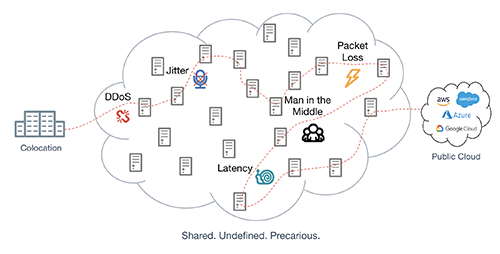Navigating the Hybrid Journey
This isn’t to say that the Internet is a panacea for enterprise networking needs. The Internet is a scary place, after all. For starters, there is no service level agreement (SLA) for the global Internet. Sure, you may get an SLA from your local Internet service provider (ISP), or even on a Tier-1 carrier’s backbone, but any assurance of reliable service is thrown out the window the instant you cross from one network to another or connect to a CSP. The Internet is a loose collection of networks connected by peering arrangements and agreements. There isn’t a single oversight body that regulates things like peering oversubscription, congestion, de-peering, and so on. This is to say nothing of major service providers that effectively service the Internet as a whole, such as Amazon, Cloudflare, and others.

Figure 1 - The precarious nature of hybrid networks
As with public transit infrastructure, however, traditional private networks have their own challenges and drawbacks. Private networks offered by legacy telecom operators typically come with hefty minimum contracts, expensive pricing, are extremely inflexible, and require very long provisioning times (more than 120 days can be common). Additionally, the customer is responsible for all of the planning, engineering, and integration with other providers and networks for redundancy and resiliency.
If we consider for a moment the pure aspect of service quality, one could envision a hybrid approach that takes advantage of the best of both public and private network infrastructure, coupling them together to build a better end-to-end solution. Imagine a solution that leverages the ubiquitous nature of Internet access combined with SD-WAN overlay for first- or last-mile solutions, terminating into a private network for the long middle mile, then connecting directly to the cloud or back to another SD-WAN-enabled first or last mile. If properly engineered, a hybrid model could deliver better performance and enable traffic to stay “on-net” with each carrier as much as possible, with well-defined, highly SLA’d network integration points between them.


















